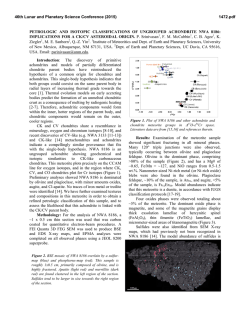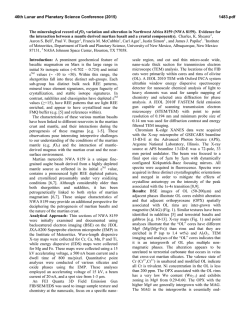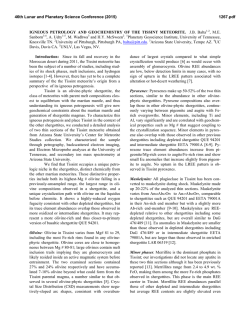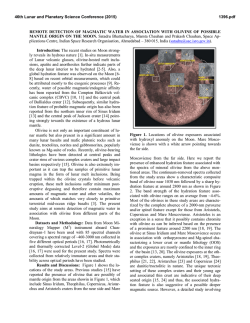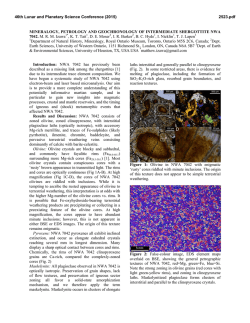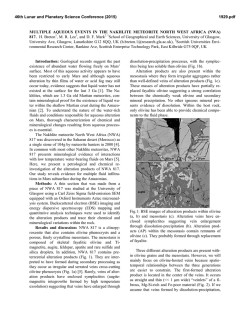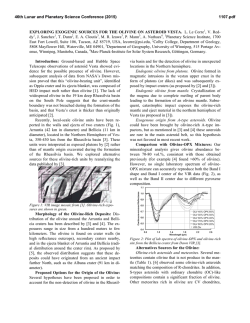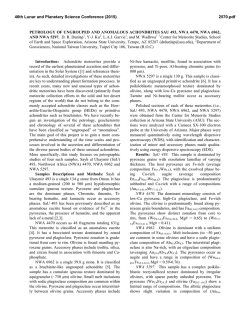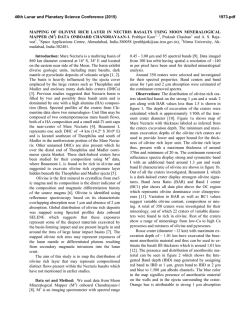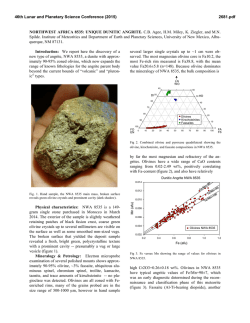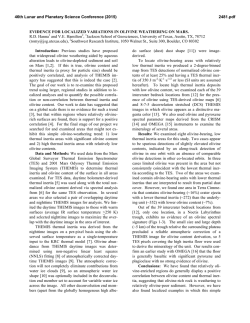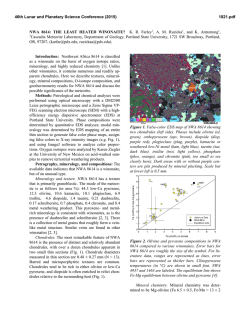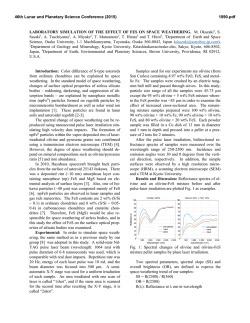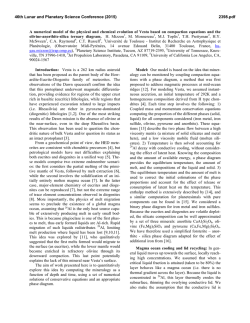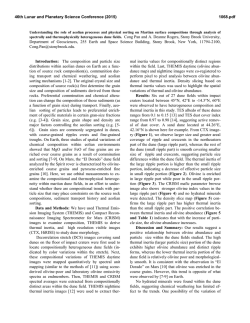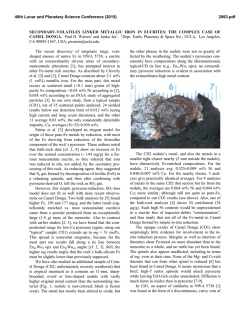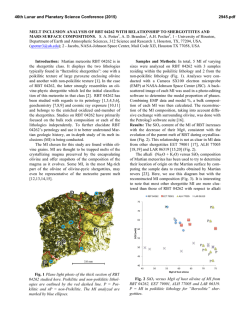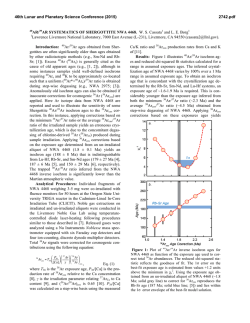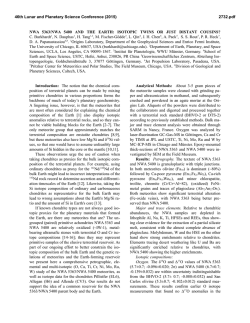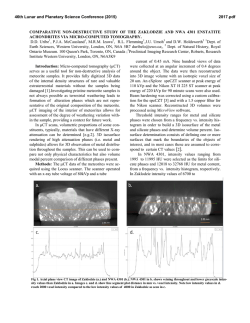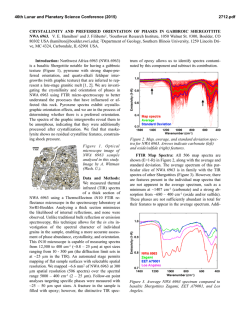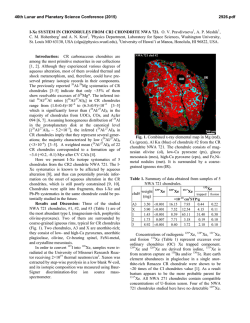
PETROLOGY OF DIOGENITE NWA 5480, A - USRA
46th Lunar and Planetary Science Conference (2015) 2221.pdf PETROLOGY OF DIOGENITE NWA 5480, A PRISTINE OLIVINE-RICH DEFORMED HARZBURGITE. A. H. Peslier1 , A.D. Brandon2, J. A. Tarduno3 and D. W. Mittlefehldt4, 1Jacobs, NASAJohnson Space Center, Mail Code XI3, Houston TX 77058, USA, [email protected], 2University of Houston, Houston TX 77204, USA, 3University of Rochester, Rochester NY 14627, USA, 4NASA-Johnson Space Center, Houston TX 77058, USA. Introduction: Diogenites are achondrites that are part of the HED (howardite, eucrite, diogenite) meteorite group thought to originate from asteroid Vesta [1]. This suite of igneous rocks offers a glimpse of early planetary differentiation and subsequent igneous processes [e.g., 2-4]. While eucrites represent asteroidal basaltic crust and howardites the impact brecciated surface, diogenites are samples of the mantle and lower crust. Most of them are orthopyroxene (Opx) dominated cumulates, although harzburgites and rare dunites have also been found [5]. The majority of diogenites are impact breccias [6]. This study describes NWA 5480, a pristine, i.e. hardly altered and minimally shocked, harzburgitic diogenite. North West Africa 5480: Found in Mali in 2008, this meteorite consists of 7 paired stones totaling 4.91 kg [7]. Oxygen isotopes and Fe/Mn ratios have been used to classify this meteorite as belonging to the HED group [8]. NWA 5480 is a particularly interesting diogenite because of two characteristics: 1) Its texture is highly deformed and is best explained by plastic deformation that occurred after crystallization at mantle pressures [9]. Only one other diogenite, maybe 2, have retained evidence for similar deformation [10]. Such expression of high stresses in the diogenite parent body resulting from geodynamic convection in an extraterrestrial planetoid is so far unique in meteorites. 2) NWA 5480 preserves a relatively strong magnetic field, providing direct evidence for an early core dynamo in Vesta [11]. Methods: One thin section is being investigated using a petrographic microscope and a JEOL JXA8530F electron microprobe. EDX elemental maps and WDS analyses of all phases have been obtained. Texture: Our thin section is characterized by parallel bands of olivine-dominated zones (Ol-zone, Fig. 1) and Opx-dominated zones (Opx-zone, Fig. 1). Olivine ranges in size from tens of µm (poikilitic in Opx) to mm, although the largest olivines (as seen in BSE images) are actually aggregates of smaller grains with variable orientation (as seen with cross-polar light photos, A in Fig. 2). The Ol-zone is characterized by trails of olivine grains of various sizes (schlieren). Olivine grains always have rounded edges and most are anhedral. Opx is typically subhedral, mm in size and is riddled with poikilitic olivine (B in Fig. 2). Opx grains, best seen in cross-polar light, do not show any alignment. Chromite occurs either as subhedral grains, 100 µm wide and with resorbed margins or as amygdoidal blebs < 10 µm wide at the edge of olivine (C in Fig. 2). Metal and troilite, <10 µm in size, are scattered throughout the thin section. Although the texture of the Ol-zone is symptomatic of plastic deformation [9], individual grains of olivine and Opx do not show undulose extinction in cross-polar light. Fig. 1: EDX map of thin section of NWA 5480 46th Lunar and Planetary Science Conference (2015) B" A" B" C" A" 1"mm" Fig. 2: Crossed polar light photo (top) and BSE image (bottom) of NWA 5480 centered on large olivine (A). B = Opx with poikilitic olivine; C = chromite blebs. Composition: Minerals of NWA 5480 are remarkably homogeneous, independently of their size or location. The Mg# of olivine, Opx and chromite are 70, 75 and 20 respectively, within the ranges of other diogenites (66-78, 74-77, 14-32 respectively [1]). Opx is also typical for diogenites Wo2En73Fs25. The only compositional variation evidenced is in Fe metals which contain less Ni (<0.3 wt %) and Co (<0.9 wt %) when enclosed in olivine then when in contact with Opx (>2 wt % Ni, >1 wt % Co). Discussion: One conundrum for understanding NWA 5480 is whether its texture and composition is of igneous and/or of metamorphic origin. Olivine orientation in the Ol-zone has been interpreted as solid-state plastic deformation between 1000 and 1250 ºC [9] but is not compatible with dynamic recrystallization [12]. Our best interpretation of NWA 5480 to date is thus as an igneous texture that was subsequently deformed and then sustained sub-solidus re-equilibration. The poïkilitic texture of the Opx and the rounded shape of 2221.pdf olivine and resorbed edges of chromites could indicate crystallization of a mafic melt at low pressure (< 5kb). Olivine and spinel crystallize first. Decreasing temperature brings the system to the peritectic where Opx starts crystallizing and olivine reacts back with the melt to form Opx [13]. The Opx are smaller than typically found in opx-rich diogenites where they can reach cm sizes [1]. This could indicate faster cooling for NWA 5480 melt. Absence of undulatory extinction, however, could signify that deformation occurred before complete solidification of the harzburgite. Deformation was accommodated by disaggregating large olivines but seemingly did not affect the Opx probably because Opx is stronger than olivine [14]. This is consistent with the more random orientation of the poikilitic olivine in Opx while the olivine in the Ol-zone has lattice preferred orientation [9]. An additional deformation event may be evidenced in the bending of the parallel Ol- and Opx zones which range from vertical to almost horizontal from the bottom to the top of Fig. 1. Compositional homogeneity of the main phases and the Ni and Co-poor nature of olivine enclosed metal could indicate re-equilibration via long-term diffusion. Temperature and oxygen fugacity at equilibration were calculated at 2 kb to be 1000ºC and -6.2 ΔFMQ (-2.5 ΔIW) using the Computational Thermodynamics server of [15]. Such a low oxygen fugacity is consistent with the presence of metal in NWA 5480. References: [1] Mittlefehldt (2014) CE, in press. [2] Allègre et al. (1975) Science, 187, 436-438. [3] Nyquist et al. (1986) JGR, 91, 8137-8150. [4] Tera et al. (1997) GCA, 61, 1713-1731. [5] Shearer et al. (2010) GCA, 74, 4865-4880. [6] Beck & McSween Jr. (2010) MAPS, 45, 850-872. [7] Weisberg et al. (2009) MAPS, 44, 1-33. [8] Irving et al. (2009) 40th LPSC. [9] Tkalcec et al. (2013) Nature Geoscience, 6, 93-97. [10] Tkalcec & Brenker (2014) MAPS, 49, 1202-1213. [11] Tarduno & Cottrell (2012) 43rd LPSC. [12] Zhang et al. (2000) Tectonophysics, 316, 133-152. [13] Bowen (1914) AJS, 38, 207-264. [14] Yamamoto et al. (2008) PCM, 35, 249-257. [15] Sack & Ghiorso (1991) AM, 76, 827-847.
© Copyright 2026
